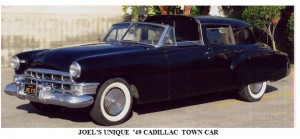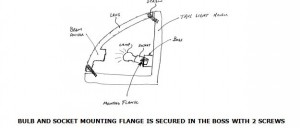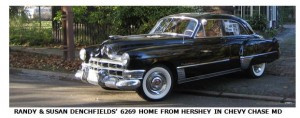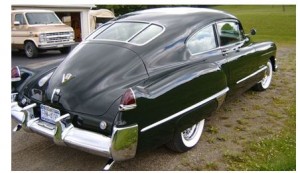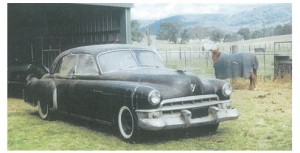I acquired my 49-6207 in June/July of 2007, commenced the restoration process in February 2008 and completed it in September 2009. In actual fact the story is much longer than that. My very first car was a 1940 LaSalle in high school and later I had other cars, but underneath all was a fascination with 1948 and 1949 Cadillacs, especially the Club Coupe. As a college student an older neighbor had a 48-6207 in dark green metallic, which was always pristine with its wide whitewalls, Sombreros and “Rainbow” dash. Though I lusted after that car, it was never for sale, so life moved on. “It” was “sacrificed” on the altar of wives, kids, houses, careers etc., but that’s when “it” started.
As the years went by that iconic 61/6207 Coupe “stuck” in my head, so I scanned the magazines for interesting candidates, but most were too far away or too something. Then I came upon a ’49 6207 close to home in Sandy, Oregon, which demanded investigation. Its second owner, a 75 + year old gentleman, had purchased it from the estate of its original owner in California over thirty years before. Anyhow, he determined that I knew a bit about Cadillacs and would not make it into a Street Rod but, sadly, the price was too high. Less than a month later I received a call from him stating that he had sold his house and was retiring to Idaho. The price for car and many spare parts was too good to let go and was conditional upon my “swearing” not to make a mess of the car.
Before I began the restoration, I re-joined the CLC and purchased the shop and authenticity manuals for the car, which I strongly recommended to anyone commencing a restoration. The “49ers, especially Joe Cutler, bailed me out of numerous detailed sticking points, as well as Cliff Houser (locally) whose French Grey 49-6207 is featured in “Cadillacs of The 40s”. Also, Ed Cholakian helped fill many Steele rubber orders and sort through pesky details like non functional fuel pumps, wiper motors and others.
The actual process began with media blasting the car to bare metal. There was no rust but the “dryness’ had a down side as all the rubber parts were done for. Though the body was damage free, there was a fair amount of effort devoted to clearing up the many little dings, ripples and such. Research in the first edition of the Authenticity Manual showed that the cowl tag paint number indicated the original color was # 16 “Lucerne Green –Metallic”, of which samples were discovered beneath some undercoat in the rear fender wells. This was replicated with especial care and attention given to getting the metallic aspect correct for 1949 with DuPont Chroma Base Coat-Clear Coat urethane.
Then it was time to look at the interior, which coincided with the publication of the 2nd edition of the Authenticity Manual. Luckily for me, the manual had numerous detailed shots of a ’49 with the same interior option, #43, as mine; that being Chocolate Brown wool broadcloth with taupe Bedford Cord. SMS in Portland OR was not only able to furnish the correct upholstery, but the correct brown “vinyl” for the package tray, rear seat backs, front kick panel and door arm rests. The trunk was another matter, as no one locally could relate to the “Oyster” colored hopsack pattern material. But the value of the Club came through again, as Joe Cutler and I traded some parts I had for this material. The rest is history.
The engine was not rebuilt, as it had been done less than 17,000 miles before, though it was in serious need of a complete tune up. I thought the transmission was bad due to hard shifting, but this was due to the fluid level being 3 quarts low and the carburetor “kick-down” rod being totally out of adjustment. A ‘49 Times article and the Shop Manual sorted these out. The “slow starter” was due to an incorrect (too small diameter, 12 volt?) positive battery cable which was corrected, along with a new starter solenoid. The 6 volt starter now gets the job done. It’s amazing what happens when you use the correct parts. So now I have a good-running example of a 49-6207. The previous owner contacted me to offer his family’s approval for bringing the car back to its intended level.
Modesty aside, I’m pleased with the outcome. Again, it could not have been achieved without the help of a lot of people within CLC and the ‘49ers. Even in a sad state these cars are beautiful iconic design pieces. Hopefully this one can take its place among the other great examples that helped me through the process.

newsletter
